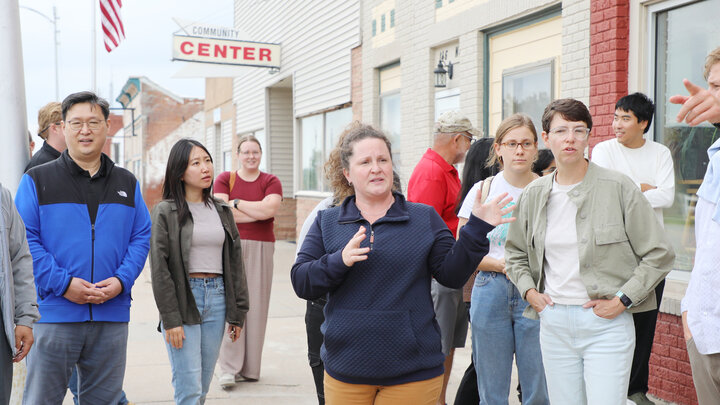Great places to live rarely happen by accident. Sought-after cities and neighborhoods take years of planning to develop, maintain and in some cases redevelop. Most cities have areas that are economically depressed and in need of revitalization. Assessing the condition of these older neighborhoods is an important first step in planning for positive change. Graduate students pursuing the Master of Community and Regional Planning (MCRP) degree at the University of Nebraska–Lincoln have been collaborating this semester with NeighborWorks Lincoln, the Lincoln/Lancaster County Planning Department and the City of Lincoln Urban Development Department in the initial stages of community planning in one of Lincoln’s older neighborhoods.
Residents’ concerns about vacant and neglected properties, graffiti, weeds, litter and other safety and quality-of-life concerns prompted the collaboration between the NeighborWorks Lincoln and the Community and Regional Planning (CRP) program. NeighborWorks Lincoln is one of over 240 nonprofit community development organizations in the NeighborWorks America network. This 2010 pilot project, funded by the Woods Charitable Fund, allowed the work to assess physical conditions, especially the housing stock, in several of Lincoln’s older neighborhoods.
Even though that grant-funded project has ended, the need to assess and improve Lincoln neighborhoods still exists. NeighborWorks Lincoln is currently in the process of developing more moderate- to low-income housing in Lincoln’s South Salt Creek Neighborhood, either by building new construction and/or rehabilitating existing homes.
The collaborative emphasis involves much more than a focus on improving housing; NeighborWorks and CRP want to see the neighborhood holistically enriched and stimulated as a result of residents becoming involved in a community planning process.
As part of the collaboration, CRP agreed to participate in the data collection and analysis process in the South Salt Creek Neighborhood as the focus of a semester-long master’s studio project. Students have conducted a door-to-door survey of residents and a condition-of-properties observational survey that uses 35 physical conditions criteria in order to build a quantitative database. In addition to the questionnaires, the team has met with neighborhood residents to inform the community about their work and gauge interest for future grassroots efforts.
This partnership has apparently been beneficial to everyone involved. For the students, it is an invaluable learning experience. “This is a great opportunity for students to conduct field work, assemble and analyze data, and understand the relationship between nonprofit organizations and city governments and how they interact and work together,” commented Gordon Scholz, CRP professor and interim program director. For NeighborWorks Lincoln and the neighborhood residents, the project has helped identify and provide evidence of issues in the neighborhood, as well as generate interest and elicit participation from residents. Furthermore, the project is providing a foundation for further neighborhood revitalization planning efforts.
“There are only two staff persons at NeighborWorks Lincoln who work with community engagement, so we’re pretty swamped. This background information-gathering which the students have conducted is a crucial first step in preparing to create a revitalization plan for any area. NWL and CRP have a long history of working together, which is a win/win because it expands NWL's capacity, provides students with hands-on experience and benefits the community,” stated Pat Anderson-Sifuentez, community builder for NeighborWorks Lincoln. She continues, “City staff members have been cut back over the years, so if CRP students can assist with gathering and analyzing some information necessary, such as census data, property assessment scans and resident surveys, it helps NWL and Planning staff in their work.”
One of the reasons this partnership was worked well thus far is the mutual understanding of community planning as a long-term and continuing process. “At the outset in this project, Gordon Scholz, NWL staff and Lincoln Planning and Urban Development staff met to make sure that the information gathered would be put to good use,” said Anderson-Sifuentez. “The work has already evolved over the years from doing just scans of properties, expanding to include resident surveys and public meetings. I hope we can continue to build on this process so that future University classes can build on what the previous classes have done.”
When the semester ends, it doesn’t mean a student has to stop working on the project, Scholz adds. “After this semester, if a student wants to continue working on the project, they can choose to pursue it through independent study or a professional project in subsequent semesters.”
In addition to supporting community development work, NeighborWorks Lincoln sees this project not only providing students with a great learning experience, but also impacting future individual decisions made by each student. “These students are improving the community they live in, and projects like this also serve as a way to connect students with meaningful service learning opportunities that will engage them with the community and possibly encourage them to stay in the area after graduation,” stated Chief Operating Officer of NeighborWorks Lincoln Shawn Ryba.
An affinity for Lincoln and its residents may have started to take root among the students.
“It was great to interact with residents of the community, and it will be fun to watch the exciting future this community has in store,” commented CRP student Maggie Harthoorn. Other students were equally enthusiastic about their skill development throughout this semester-long project.
“This experience has helped me to hone my GIS, Illustrator and InDesign skills in an environment with real deadlines and deliverables to a third-party partner such as NeighborWorks,” commented CRP student Andy Pedley.
As a culmination of their community condition analysis, CRP students will make recommendations to NeighborWorks Lincoln for community improvements in the neighborhood they have studied. These results will give city stakeholders a useful perspective regarding the conditions of this neighborhood and a reference for future planning and decision-making.




